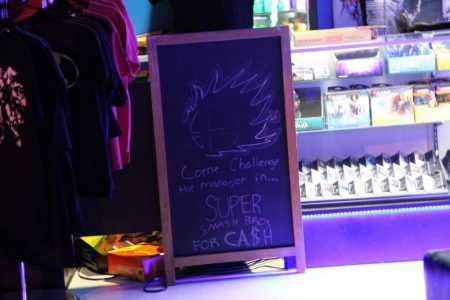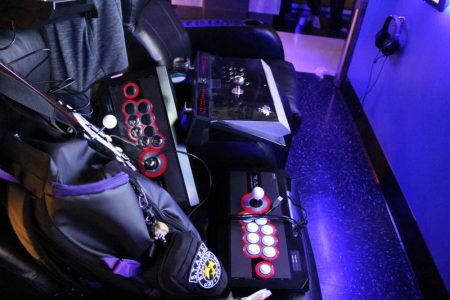The atmosphere is calm but you can feel the tension building in the air. Lights flash and blaring sounds clog the walls of the building. The monitors are lined up like soldiers ready for war. Your palms begin to clam up when the game isn’t going your way. Soon, you feel the euphoria of pride yet humbleness for the victory you have received. You shake hands with your opponent. Win or lose, you learn. Welcome to fighting games.

Fighting games themselves take place in the virtual world of high-tech computers, fast or even at times laggy internet. But, they’ve increasingly become a way for people to build communities in real life.
This year there have been more than six local tournaments in Fullerton with some that are monthly or bi-weekly. So there is quite a variety of competition.
For the fighting game community—known as FGC by those who are a part of it—local tournaments are one of the best places to connect and build relationships and skills.
The bonds grow out of a shared dedication to an extremely complex hobby. Players put in so much time and effort executing combos and the number of frames needed for specific moves that they can appreciate when other people are able to accomplish the same feats.
“As a commentator, I would generally get better players to show the fundamentals to newer players,” says Quinlan Cantrell, manager of PLAYLive, a gaming and virtual reality venue in Fullerton that hosts many local tournaments.x
The way the local tournaments work is very simple. You walk to the location, buy your spot in the bracket or even just walk straight in and play. Then there are times where the brackets are uneven so at the moment the tournament organizers figure out the optimal way the tournament should be held.
Since the unevenness of the tournament, the same can go for the prize pool. If you go to Frank and Son’s, the pot is $1,000 and is distributed to the top eight players. It is distributed by how you place. Another case would be in PLAYLive, a group called DangerTime occasionally gives prizes to people who place top three — they will then also have a spot in a major tournament.
“I like how the community has made a game that was not competitive into one,” says Juan Chavez, a participant at the Smash Ultimate tournament. He explains how the games prior were not competitively friendly, but the community made it one.
Even though tournaments are highly competitive, players also like to encourage others to get into the scene. This is what makes the FGC a very tight-knit group. But you still tend to get a couple of bad apples. Just by going to YouTube you can find players being disrespectful through compilations or just small clips through Twitter. This seems to divide the community with players being more orthodox to the whole competitive nature and don’t branch to newer players.
People also play fighting games for the thrill. “The scene is energetic. You enter the tournament and it just wakes you up,” says Ivan Canteria, a participant in the Smash Bros. Ultimate tournament at PLAYLive.
Some people come just to watch the matches and spend time with their friends at PLAYLive. The people who come to watch are the people who just love the game for what it is, not what you can become out of it.

Some bigger tournaments like SoCal Chronicles have a spectator pass for $5-10, while local tournaments are free for spectators.
For some, local tournaments aren’t just for bonding, but they’re good practice ground for major tournaments.
To see the prospect of growth in the FGC we can see the prize pools for major tournaments like Evo. As of 2019, Smash Ultimate was the biggest prize pool mainly for the significance of participants at the tournament — the bigger the tournament the bigger the prize pool.
“Usually we get more people that enter local tournaments when there is a big tournament coming,” says Cantrell.
In Evo 2019, one of the biggest global e-sports championships, the Pakistani players beat the best players in the world in the game Tekken 7. This was because the players in Pakistan couldn’t go to other countries to compete in major tournaments because of travel restrictions—something that worked to their advantage, according to The Washington Post. By playing only in local tournaments, they developed a different play style from what was originally thought to be the standard in professional tournaments.
The way the local scene affects Pakistan is the same way it affects Fullerton’s FGC community. The local scene gives all fighting game players in every country an opportunity to gain an elite level at the game through the tournaments held in their community. These local tournaments allow players to develop their own style of play as well as good competition from other players and their different play styles.
Players differentiate themselves and their unique play styles with their controllers, known as fighting sticks, which they often bring in themselves. Fighting sticks are different depending on who you talk to with prices ranging from $350 to $36. Many players choose to make their own fighting stick, which is cheaper and offers them more variety. These homemade ones are often better quality than the cheapest ones on the market.

The local scene is an intriguing experience as it allows all types of skilled people in your area to learn and connect. But, in the end, it’s mostly just about having a good time.
“Community first, game second,” says Quinlan.


